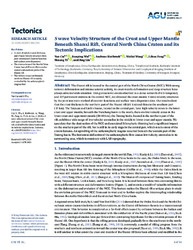S wave Velocity Structure of the Crust and Upper Mantle Beneath Shanxi Rift, Central North China Craton and its Tectonic Implications
DOI: https://doi.org/10.1029/2020TC006239
Persistent URL: http://resolver.sub.uni-goettingen.de/purl?gldocs-11858/9524
Persistent URL: http://resolver.sub.uni-goettingen.de/purl?gldocs-11858/9524
Cai, Yan; Wu, Jianping; Rietbrock, Andreas; Wang, Weilai; Fang, Lihua; Yi, Shuang; Liu, Jing, 2021: S wave Velocity Structure of the Crust and Upper Mantle Beneath Shanxi Rift, Central North China Craton and its Tectonic Implications. In: Tectonics, Band 40, 4, DOI: 10.1029/2020TC006239.
 |
Dokument öffnen: |
The Shanxi rift is located in the central part of the North China Craton (NCC). With strong tectonic deformation and intense seismic activity, its crust‐mantle deformation and deep structure have always attracted wide attention. Using teleseismic events observed in a dense network of 610 temporary and 127 permanent stations in the central NCC, we obtained the crust‐mantle S wave velocity structures by the joint inversion method of receiver functions and surface wave dispersion data. Our results show that the crust thickens in the northern part of the Shanxi rift (41 km) and thins in the southern part (35 km). The Taiyuan and Linfen basins, located in the central part, have high‐velocity zones in the lower crust and upper mantle; beneath the Yuncheng basin in the south, there are low‐velocity zones in the lower crust and uppermost mantle (30–80 km); the Datong basin, located in the northern part of the rift, exhibits a wide range of low‐velocity anomalies in the middle to lower crust and upper mantle. We speculate that the destruction of the NCC and associated lithospheric thinning had a significant impact on the southern part of the rift, but is still in its early stage in the central part, which retains most of the craton features. An upwelling of the asthenospheric magma occurred beneath the western part of the Datong basin. The horizontal deflection of the asthenospheric flow causes low‐velocity anomalies in its surrounding area, which is consistent with LAB topography. Key Points:
A more detailed crustal thickness and S wave velocity structure from joint inversion of receiver function and surface wave dispersion.
The destructions of the North China Craton have different effects on the central and southern parts of the Shanxi rift.
The velocity structure beneath northern Shanxi rift is mainly controlled by the asthenospheric magma flow.
Statistik:
ZugriffsstatistikSammlung:
This is an open access article under the terms of the Creative Commons Attribution License, which permits use, distribution and reproduction in any medium, provided the original work is properly cited.

